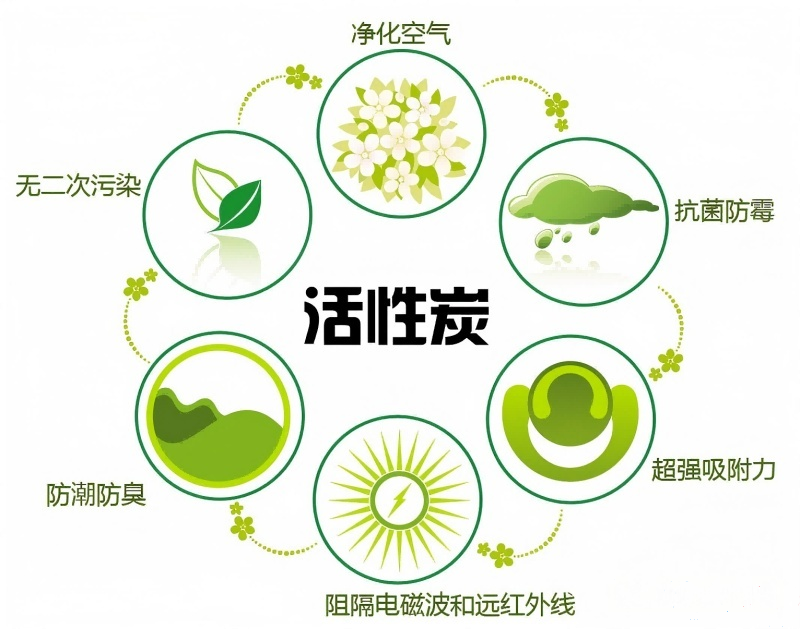Marketing Hotline:
(+86)0532-88988868
(+86)0532-88988868
What are the categories of activated carbon?
1. Based on different raw materials for producing activated carbon, activated carbon can be classified as:
(1) Wood-based carbon: which can be subdivided into charcoal (made from wood chips), bamboo charcoal (made from bamboo), nut shell carbon (made from walnut shells or apricot pits), and coconut shell carbon (made from coconut shells). Coconut shell carbon or nut shell carbon is commonly used in water purifiers.
(2) Coal-based carbon (made from anthracite, with better quality from Ningxia).
(3) Bone charcoal (made from animal bones).
(4) Silver-loaded activated carbon: Generally, it uses nut shell activated carbon as raw material and employs special processes to load silver, with a silver content typically between 0.1% and 0.3%. It gradually releases silver ions (Ag+) in water, which have bactericidal effects. Therefore, silver-loaded activated carbon not only has the adsorption function of ordinary activated carbon but also suppresses bacterial growth. It is essential to use high-quality silver-loaded activated carbon in water purifiers; otherwise, the silver ions in the initial water output may exceed the standard, and after a short usage period, no more silver will be released.
2. According to the different forms of activated carbon, the commonly used activated carbon in household water purifiers can be divided into:
(1) Powdered Activated Carbon (PAC). Powdered activated carbon is actually a finer particle size of granular activated carbon. Due to its smaller particle size and larger specific surface area, its adsorption effect is better than that of common granular activated carbon.
(2) Granular Activated Carbon (GAC). This is the most commonly used activated carbon in water purifiers. The smaller the particles, the better the adsorption effect, but the water resistance (inlet and outlet pressure difference) increases, and it is also easier to lose carbon. Therefore, manufacturers of water purifiers should choose the appropriate particle size. In large water treatment equipment, 10 to 24 mesh (Φ2.0 to 0.8mm) is often selected, while for small household water purifiers, due to the short height of the carbon column, fast flow rate, and short contact time between water and activated carbon, it is recommended to choose 16 to 32 mesh (Φ1.3 to 0.6mm).
(3) Activated carbon fiber felt (ACF) can be classified into two types based on raw materials: one type is made from rayon-based fiber filaments, processed into fabric, and then carbonized, activated, and subjected to high-temperature treatment; the other type is made from polyacrylonitrile-based fibers, processed into felt, and then pre-oxidized, carbonized, activated, and exposed to high-temperature treatment. The average pore diameter for the former is 17 to 26 angstroms, while for the latter it is 10 to 20 angstroms. Activated carbon fibers are commonly made into felt that is 1 to 5 mm thick, and they have more micropores than granular activated carbon, a larger specific surface area (1000 to 1600 m²/g), a greater adsorption capacity (2 to 6 times higher), and a faster adsorption rate, along with good regeneration performance, fast desorption rates, and reusability. The drawbacks include a higher price and susceptibility to bacterial growth.
(4) Sintered activated carbon filter cartridges (CTO), also known as carbon block filters or compressed activated carbon filters, are made by adding a binder (such as PE resin) to granular activated carbon, which is then heated, sintered, and molded. The outer layer of the carbon core is often wrapped in white polypropylene (PP) non-woven fabric. Sintered activated carbon filter cartridges serve both adsorption and filtration functions (average pore size of 3 to 20 micrometers), but their filtration capabilities are lower than that of PP melt-blown filter cartridges, and their adsorption capability is lower than that of granular activated carbon filters.

The role of activated carbon in water purifiers
1. The water purification function of activated carbon
Activated carbon can remove odor and taste, color, residual chlorine, colloids, organic matter (synthetic detergents, pesticides, herbicides, insecticides, synthetic dyes, trihalomethanes, haloacetic acids, endocrine disruptors such as phthalates PAES, etc.), heavy metals (such as mercury, silver, cadmium, chromium, lead, nickel, etc.), radioactive substances, etc. from water. It is the earliest and most widely used water purification material in water purifiers. Not only in general activated carbon water purifiers, but also in household reverse osmosis pure water machines, as well as in most ultrafiltration, ceramic, KDF, UV and other water purifiers, activated carbon is used.
Both activated carbon and KDF can remove residual chlorine from water, but KDF reacts with chlorine to form zinc ions (Zn2+), which may cause zinc to exceed the standard in water. However, there is no such concern when using activated carbon to remove chlorine. During the activation process of activated carbon, a large number of tiny pores of various shapes are formed, constituting a huge adsorption surface area. Its specific surface area is 500-1200 m2/g. The larger the specific surface area, the better the adsorption effect.
2. Negative Impacts of Activated Carbon
(1) Activated carbon adsorbs a large amount of organic matter, which can serve as nutrients for bacteria and other microorganisms. These microorganisms can multiply and proliferate in the micropores of activated carbon, potentially leading to an excessive total bacterial count in the effluent.
(2) In water purifiers, activated carbon, under the catalytic action of microorganisms, converts ammonia nitrogen in water into nitrite nitrogen. It is common for the nitrite content in the effluent from water purifiers to be many times higher than that in the influent. Nitrite itself is not a carcinogen, but when it reacts with amine substances in water, it forms nitrosamines, which are strong carcinogens.
(3) Adding bromine resin (brominated polystyrene hydantoin) filtration or UV sterilization to the effluent from activated carbon adsorption filtration is an effective method to address excessive microorganisms in water.
3. Mechanism of Activated Carbon Adsorption
(1) Physical Adsorption: Van der Waals Forces. Activated carbon can remove organic matter, colloids, etc. in water through physical adsorption.
(2) Chemical Adsorption: Chemical Reactions and Catalytic Effects. Activated carbon can remove residual chlorine, chloramines, etc. in water through chemical adsorption.
What are the functions of activated carbon?
1. Used in the manufacture of gas masks
Activated carbon was originally used to make gas masks. With the progress of the times, it was gradually applied in water treatment plants for deodorization. Later, its applications became increasingly widespread, such as in cigarette filters, sugar decolorization, military gas masks, detoxification, treatment of radioactive element pollution, soil improvement, hangover relief, and indoor formaldehyde control. Therefore, the answer to the question "Can activated carbon remove formaldehyde?" is self-evident.
2. Possessing a unique porous structure
We all know that activated carbon is a microcrystalline carbon material made of carbon material, featuring a well-developed internal pore structure, a black appearance, strong adsorption capacity, and a large surface area. Moreover, activated carbon contains many micropores that are invisible to the naked eye, and these micropores have great uses. It is precisely the excellent pore structure of activated carbon that gives it its powerful adsorption function.
3. Interaction force
Although the speed of molecular motion is influenced by material and temperature, its movement within the microenvironment is endless. Due to the mutual attractive forces between molecules, when a molecule is captured by the internal pores of activated carbon and enters the pores, it triggers continuous attraction between molecules until the activated carbon's internal pores are filled.
4. Capable of adsorbing various harmful substances
It is understood that high-quality coconut shell activated carbon can adsorb a large amount of harmful gases. However, activated carbons made from different materials have varying inner pore sizes, resulting in differences in their adsorption capabilities.


